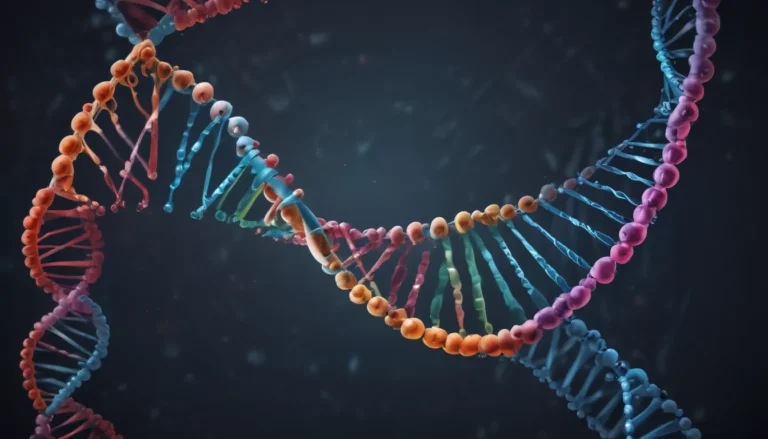A Note About Images: The images used in our articles are for illustration purposes only and may not exactly match the content. They are meant to engage readers, but the text should be relied upon for accurate information.
Protein folding is like origami for molecules—essential for their proper function and crucial for maintaining cellular health. In this article, we will delve into the captivating world of protein folding, exploring ten astonishing facts that shed light on its significance in biology and its wide-reaching implications.
The Intricate Dance of Protein Folding
Protein folding is a complex biological process where proteins adopt their specific three-dimensional structure. This folded structure, known as the protein’s native conformation, is vital for its function within the cell.
Proteins are composed of long chains of amino acids, and the specific sequence of these amino acids determines the protein’s structure and function. During the folding process, these chains must fold into precise shapes to perform their intended roles effectively.
The Impact of Misfolded Proteins
When proteins fail to fold correctly, they can become misfolded or form aggregates. These misfolded proteins can accumulate in the cell and contribute to the development of various diseases, including Alzheimer’s, Parkinson’s, and prion diseases.
Molecular chaperones are proteins that assist in the folding process, guiding proteins along the complex folding pathway and preventing misfolding or aggregation. They play a crucial role in ensuring that proteins achieve their correct structure.
Genetic Mutations and Protein Misfolding
Genetic mutations can disrupt the protein folding process, leading to the production of misfolded proteins. These mutations can be inherited or occur spontaneously, contributing to genetic diseases such as cystic fibrosis and amyotrophic lateral sclerosis (ALS).
The process of protein folding is dynamic and not a one-time event. Proteins can undergo conformational changes even after reaching their native state, highlighting the intricate nature of protein structure and function.
Environmental Factors and Protein Folding
Various environmental factors, such as temperature, pH, and the presence of specific molecules, can influence protein folding. Changes in these factors can impact the stability and folding kinetics of proteins, affecting their overall function.
Scientists utilize computer simulations, such as molecular dynamics simulations, to study protein folding. These simulations provide valuable insights into the folding mechanisms, allowing researchers to gain a deeper understanding of this intricate process.
Aging and Protein Misfolding
As we age, the efficiency of protein folding decreases, increasing the risk of misfolding and aggregation. This age-related decline in protein folding has been implicated in the aging process and the development of age-related diseases.
Despite decades of research, many aspects of protein folding remain poorly understood. Scientists are continually exploring the complexities of protein folding, unraveling new insights that could have significant implications for human health and disease.
Conclusion: Unlocking the Potential of Protein Folding
In conclusion, protein folding is a fascinating process that underpins the functioning of living organisms. Understanding the mechanisms behind protein folding is essential for advancements in fields like medicine, biotechnology, and pharmaceuticals.
By gaining a deeper understanding of protein folding, researchers can develop targeted therapies and interventions to address diseases stemming from misfolded proteins. As technology advances, our knowledge of protein folding will continue to expand, offering new opportunities for scientific discovery and innovation.
FAQs: Exploring Protein Folding Further
-
What is protein folding?
Protein folding is the process by which a protein molecule assumes its functional, three-dimensional structure, essential for its proper function within the cell. -
Why is protein folding important?
Protein folding is crucial as it directly influences protein function. Misfolded proteins can lead to various diseases, making understanding protein folding vital for disease prevention. -
How is protein folding controlled?
Protein folding is controlled by factors like amino acid sequence, environmental conditions, and the assistance of molecular chaperones. -
Can protein misfolding cause diseases?
Yes, misfolded proteins can lead to diseases like Alzheimer’s, Parkinson’s, and cystic fibrosis by disrupting cellular processes. -
How do scientists study protein folding?
Scientists use techniques like X-ray crystallography, NMR, and computer simulations to visualize protein structures and understand the folding process. -
Can protein folding be manipulated?
Researchers are exploring protein folding engineering to correct misfolding and develop therapeutic interventions for associated diseases.
Dive Deeper into Biological Processes
Protein folding is just one captivating aspect of biology’s intricate world. Glycosylation, the process of adding sugar molecules to proteins, also influences function and stability. Exploring these processes opens up new possibilities in medicine and biotechnology, sparking curiosity and driving innovation.
Your Engagement Matters
Our commitment to delivering engaging and credible content relies on contributions from users like you. Each fact on our platform is meticulously reviewed by our editors to ensure accuracy and reliability. Trust in our dedication to quality as you embark on a journey of exploration and learning.
In your quest to unravel the mysteries of protein folding, remember that each discovery brings us closer to understanding the intricate workings of the biological world. Join us in this enlightening journey of scientific discovery and innovation.






